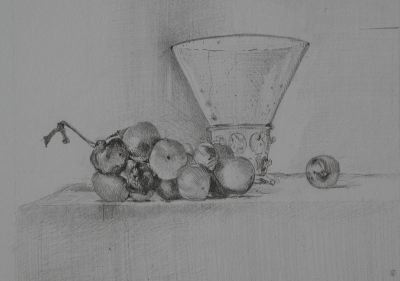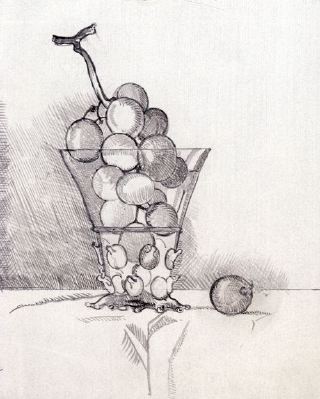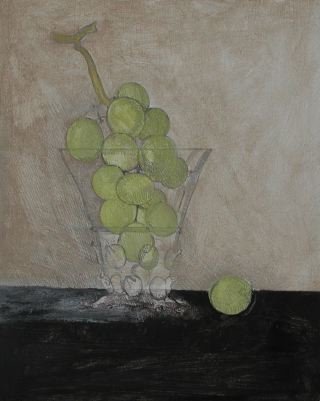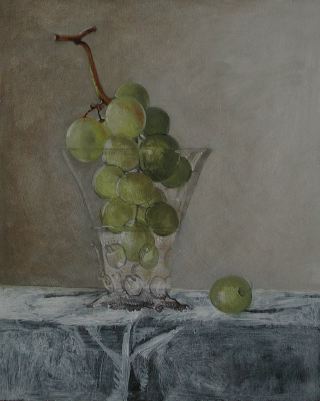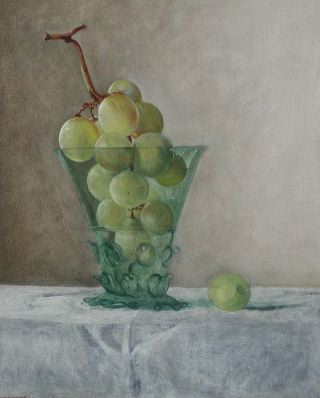Follow the Painting
Old Grapes

. . .
A drawing on paper (click image to enlarge):
Underdrawing on panel:
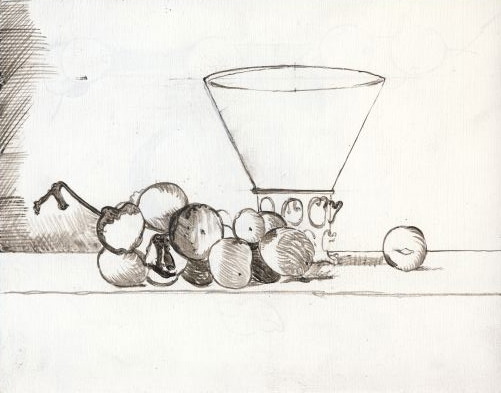
. . .
Underpainting with acrylic:

. . .
Overpainting with oil:
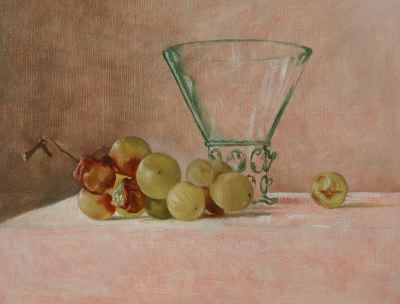
. . .
Overpainting with oil, second day (click image to enlarge):
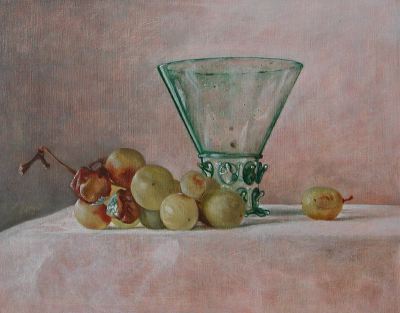
. . .
Fresh Grapes
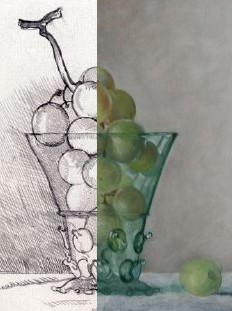 Recently we looked at one of Hanneke van Oosterhout‘s finished still life paintings. There were a number of excellent critiques. The painting was already sold, however, so comments could have no further impact on that picture.
Recently we looked at one of Hanneke van Oosterhout‘s finished still life paintings. There were a number of excellent critiques. The painting was already sold, however, so comments could have no further impact on that picture.
Now Hanneke is in the progress of making another still life. It is not yet finished, which means that your comments could help her make this painting better.
We can follow the painting’s development over several days.
Here is an underdrawing made directly on the panel with black acrylic and a fine brush. The underdrawing took less than an hour. This underdrawing was transferred from a pencil drawing on paper made the previous day (click images to enlarge; work on paper not shown).
The next day Hanneke did the underpainting in acrylic, painting over the underdrawing thinly so that the hatching shading of the underdrawing is almost hidden, but still has an optical effect. The work in acrylic took less than an hour.
Next she did a first pass at overpainting with oil, begun immediately after the work in acrylic was dry. Hanneke painted very thinly, starting with the dark tone in the background. Then she added lighter color on the right side. Then she started to paint the grapes because she understood the the grapes would not last long (but would dry out in a few days). “I gave all the grapes shading, then started to paint lighter parts. Started with left top grape, that part is done the best,” she says. She used oil paint from a tube (Old Holland) and thinned it with a bit of linseed oil. No turpentine was used.
Below is the results from another day where she overpaints with oils (the previous layer had already dried).
Below, two images from yet another day working with oil paint, where she develops the glass. First she applies a transparent “glaze” . . .
Then she works wet-in-wet in the glaze, adding highlights and deeper shadows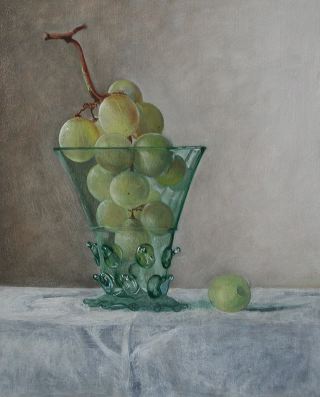
This painting is pretty good now, but it needs something. Any suggestions?
Interview with Walter Bartman
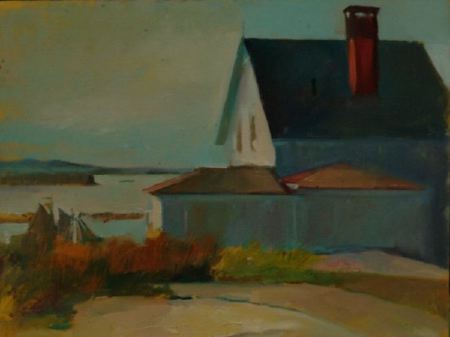
Walter Bartman was my art teacher in high school in 1984-86 in Bethesda, Maryland. Students of “Mr. Bartman” were ten times more likely to become Presidential Scholars in Visual Arts than students in other art classes in the United States. Although he retired from high school teaching in 2001, Walter Bartman continues to teach landscape painting in Maryland and in workshops across the U.S. and in Europe.
Artwork in this post is plein air painting by Walter Bartman [click images to enlarge]. This interview was edited for publication together with Leslie Holt
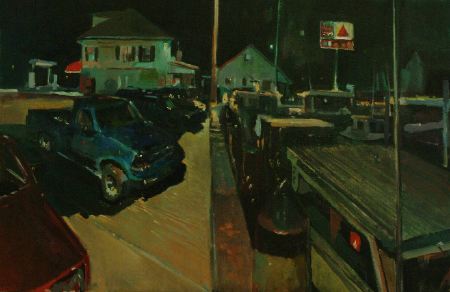
KARL ZIPSER: Walter Bartman, you give effective training in how to draw and paint, but you also give students the feeling that painting is important, help them find a passionate devotion to art. What are the key ingredients for creating an art community like the one you create among your students in your high school class?
WALTER BARTMAN: Karl, I like to think that all ideas need a catalyst, like a fire needing a spark. As an idea person, I realized I could never see all my ideas to fruition. That is what has made teaching so important to me. I found that I could share my enthusiasm and ideas for discovery with my students. I have always seen myself as someone who puts things into motion. Teaching was the perfect field for me and my temperment, though when I graduated from college, I didn’t value the importance of the profession. That came when I had actually taught and seen my impact.
As an artist, I am striving for a breakthrough in personal awareness. I feel that is what all of the “fields” of creativity are about. That should be their mission, to go beyond what is known. How you get there has many paths. I follow a path that is grounded on “digging the garden,” as Matisse put it. It is the Zen of working. Sharing that with people of similar interest seems so easy. Today, most of my students are adults and they like the younger students have seen what inspiration does at any age.
I have always led my life with six ideas…
- You can paint the sky any color you want and it will eventually happen (Any thing we dream can happen because it wouldn’t if we weren’t able to think it).
- The color you see is made by the color you just saw (everything is relative).
- It is the invisible in art that needs to be found, not the visible (clues are in the visible).
- The holy men wrote the books, they didn’t read them (be inspired to express what is in your head).
- The universe is inside me (all sensations are internalized).
- The mind prevents me from seeing, not my eyes (Getting the mind to see more…gaining a perspective on how you think)…
The most important reason I draw and paint is because I can see my ideas that are in my mind on paper. I came to realize this when I was very young. I could see in my drawings that “my personal ideas come alive”.
I always encouraged my students to build their ideas on their temperament (personal sensitivity). Understanding the perspective each student brings is important, because they share their ideas with others. Like the gardener, the plant needs nourishment at a young age, not pruning to soon. Too much direction is not healthy, I want my students to have an utmost belief in their personal ideas. I helped validate their own discoveries, with that comes personal intellectual growth.
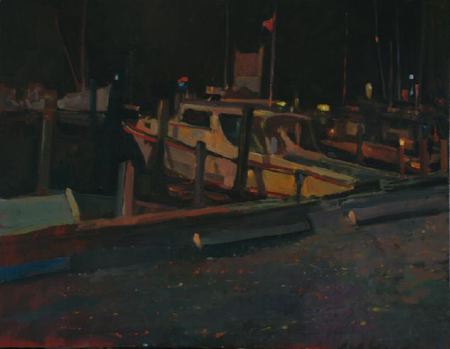
KARL: Walter, your words give me a vivid recollection of the inspiration I felt when I joined your class 22 years ago. In addition to what I gained directly from you in the student/teacher relationship, I also got much support and encouragement from your other students. Do you think this community spirit developed as a side-effect of your method of teaching individual students, or did you also specifically strive to nurture the feeling of community?
WALTER: Karl, Community has always been something I feel has made great movements in the arts, science or math. It was my intention from the very beginning to build a community of young artists as the future generation. I have always felt that human thought is collective. We build ideas on the thoughts of others. If you can bring a group of very creative people together in a sharing environment, they will support each other and challenge each other to go beyond the instructor’s expectations. I was always impressed by the enthusiasm of the students for idea making through the visual art of painting.
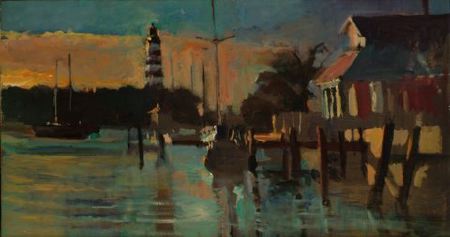
KARL: Can you comment on your approach to building this strong community of artists?
WALTER: When I came to Walt Whitman high school, I soon realized that I would build my program around a nucleus of very talented students. That nucleus would pull other students in because of the high standards and enthusiasm of a small group of students. Each year, a new group would follow. They would be identified in the beginning classes and encouraged to challenge the older students. That kept the older ones from being complacent. I was fortunate to have some really fine students. I found that each year produced a strong group of students. Instituting a yearly festival art exhibition at the school gave the students an opportunity to be showcased for their ideas. I feel creative people need to have some opportunity to display who they are.
I always tried to build a community. It wasn’t ever about one student. I find when I teach, I do it to a group, not single students. I also befriended my students. I was there to validate and support each student who gave 100%. If you remember my grading system, students only received A’s & E’s. If they received an E, they could always make up the work. I also found that quantity made quality, so I always required a lot of work.
The work I assigned was based on contemporary movements. I felt my students were a part of that movement and had something to add. It is funny, but looking back on the work in my classes, some of it was very profound for anyone at any age. I guess that is why my program was nationally recognized.
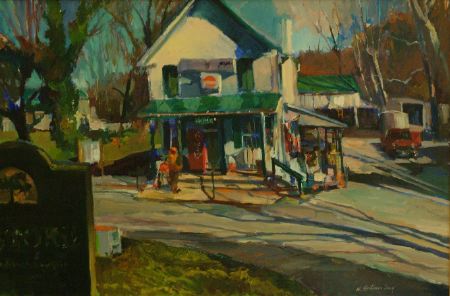
KARL: You have succeeded in building a tremendous environment for your students, a place where art matters. The results are, I think, astonishing.
However, when students left your class, even if they went to a good art school, they might discover that they do not have the same magic feeling about art as they had in your class community. What advice can you offer to your former students, and to those who will never be your students, for building and maintaining a creative environment in which to produce their art?
WALTER: The advice I would give to students is to see themselves as artists. That means they have to have the discipline to make their own work. They must be self motivated. They need to establish purpose and work toward it. They must have an absolute belief in their work and that it does make a difference.
Over the years, I tried to prepare my students for an exciting life full of art. I hoped that their experiences in my classes would prepare them. I realized after talking to a number of students that when they went off to school, many of the programs just didn’t offer that spark they were looking for. After hearing their concerns, on their return from their schools, I counseled them to seek out a community of artists nearby or to form one.
I hoped that their experience of studying with me would be enough to eventually lead them to being productive artists. All I could do was to prepare them. Hopefully, upon leaving my program, they were working as artists and just not students. Artists have to be self-motivated. I tried to instill that in their work ethic.
As their teacher, I know I instilled a guilt complex for not working up to their potential. I guess I had expectations for them. That is something I know is still present in their minds years later. However, if there is one thing I had hoped they carried with them, it would be that art makes for a fulfilling life. It is something they could do anywhere at anytime.
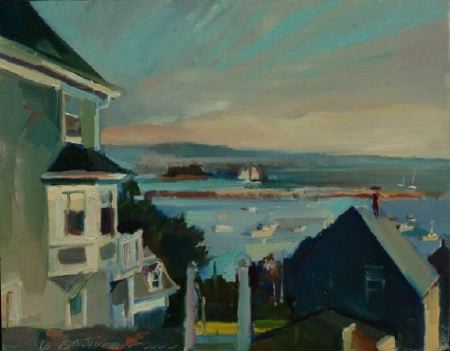
KARL: Will you take questions from readers here?
WALTER: Yes.
[to join the discussion, please go to this post over at Art & Perception]
